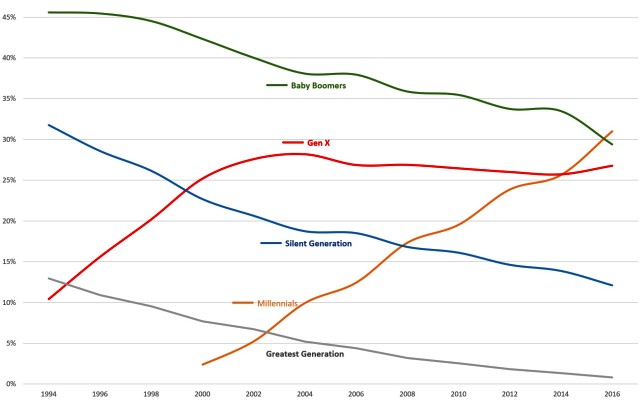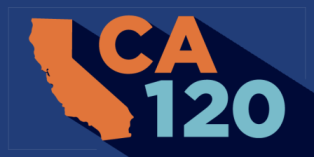News
CA120: A coming-out party for Latinos, Millennials?
 Latinos at a Los Angeles demonstration on immigration policy. (Photo: Joseph Sohm, via Shutterstock)
Latinos at a Los Angeles demonstration on immigration policy. (Photo: Joseph Sohm, via Shutterstock)↵sWith the close of registration for the 2016 general election, California’s secretary of state came out last week with final registration figures that capped off the biggest year of voter registration in the state’s history:
–Total registration is now at 19.4 million – fully a million more voters than the last statewide peak.
–A whopping record of 5.4 million voters registered or re-registered since January 1, 2016. This includes two record-setting registration periods before the primary and again before the general.
–Registrants without any prior voting history account for over three million of these registrants. That’s more people than the total population of Iowa!
–Thinking of how campaigns use data, usually at the household level for walking and mailers, an enormous 39% of voter households have a new or re-registered voter. For Latinos, it is 43%.
This story is really about two populations that we have known could, someday, dominate California elections: Millennials and Latinos.
The Latino vote has been repeatedly spoken of as a political “sleeping giant,” evoking the sense that this population could awaken and shake the foundations of our elections – potentially causing a permanent realignment of our state and national politics.
The progressive nature of these voters is probably the best justification behind the efforts by Tom Steyer’s Next Generation Climate Change efforts to drive their registration and turnout this election cycle.
Dr. Mindy Romero of U.C. Davis has helped to quantify this population in California. Her groundbreaking work in identifying these voters, and tying their non-participation to socioeconomics, should be mandatory reading for anyone who wants to understand the eligible Latino voter population.

The share of voter registration by generation, 1994-2016. (Political Data Inc.)
The other burgeoning demographic are those pesky millennials. Yes, the snapchatters and Pokemon-goers started this year as the third largest segment of the electorate and quickly became the largest generation in the state’s 19.4 million voter file.
And a recent study from the Public Policy Institute of California suggests that bringing these eligible voters — Latinos, lower income non-Latinos and millennials — into the registered population will make for a much more progressive electorate.
The progressive nature of these voters is probably the best justification behind the climate-change efforts by Tom Steyer’s Next Generation group to drive their registration and turnout this election cycle.
This significant paid effort, made possible largely because of the California’s easily accessible online voter registration, can safely take credit for a whopping 800,000 of the state’s 5.4 million new and re-registrations since January.
But with both of these populations the real question is: “Will they vote?”
And, if you think this is the last we will hear of spikes in Latino and Millennial registration, think again.
This portion of the California population is the most likely to benefit from an “opt-out” automatic registration law authored by Assemblywoman Lorena Gonzalez, D-San Diego, which will be implemented sometime in first half of 2017.
By the 2020 election cycle, we expect the voter file to top 20 million, on its way to 22 million or more by the next presidential election.
But with both of these populations the real question is: “Will they vote?”
Analyses of these early voting trends in California are complicated, particularly when looking at populations that are traditionally lower turnout, or who only vote in presidential general elections.
During the 2012 general election, there was a lot of skepticism of the newer registrants – particularly those who registered to vote online. Republican consultant Matt Rexroad famously tweeted that these online registrants would vote — just as soon as they could vote online.
Latinos accounted for a record 20% of the total votes cast, and younger voters, particularly younger Democrats, were significantly over-performing their projected numbers.
By the election, upwards of 80% of them cast ballots.
In that cycle, we really saw growth in the “presidential only” voters. Of those voters in November of 2012 who had previously registered in the months leading up to the 2008 General, only 27% had voted in any intervening election.
With this question mark over younger and Latino voters, it makes sense to look at the early votes for signs about their voting behavior. Going into this general election we have more absentee voters than ever before, so early vote counts can be misleading, as was described in this article.
More than four million of the current mail-in voters have never actually mailed in a ballot in any prior election.
As was seen in the June Primary election, much of the analysis based on early votes pointed to lower turnout among young people and sagging Latino voter participation, seen in the early figures at just 13% for Latinos and 10% for voters under 35.
But by the time all of the day-of absentee ballots and poll voters were tallied, Latinos accounted for a record 20% of the total votes cast. Younger voters, particularly younger Democrats, were significantly over-performing their projected numbers.
As of Friday, 673,895 Latinos have already returned their absentee ballots. This is only 15% of the ballots returned to date, but already a 20% increase over the total number of early Latino votes in 2012.
In digging through early vote totals, we can look into the percentage of voter turnout for populations.
It makes sense that if 36% of Democratic women with mail-in ballots had turned them in by this time in the 2012 election, then seeing 38% now would be an improvement and 34% would represent a drop.
However, we know that the new by-mail voter population includes a lot of previous poll voters who might be deemed less likely to vote. Yet, now, they are in the traditionally higher propensity by-mail pool of voters.
This would mean we are comparing high-turnout apples and low-turnout oranges.
To put a point on this: We have grown our number of mail voters by nearly 30% since 2012. But more than four million of the current mail-in voters have never actually mailed in a ballot in any prior election.
As of Friday, 673,895 Latinos have already returned their absentee ballots. This is only 15% of the ballots returned to date, but already a 20% increase over the total number of early Latino votes in 2012. With the additional mailing days, the raw number of Latino early votes should be 50% higher than previous records.
Among Latino voters with no prior vote history, those that might be deemed as less likely to vote, early returns are up 52%. This is potentially the most meaningful statistic, and one that would potentially be missed by pollsters and campaigns.
And millennials?
We know that the early votes coming in have been strongly skewed toward older voters – with nearly two-thirds of seniors voting, compared to just 13% for voters 18-24. However, as history would suggest, we have to wait a bit longer to see if these voters will mail in their ballot at the last minute, drop them off at the polls, or vote in-person.
And, again, as n the primary election, we are going to have to watch those provisional ballots that can pull the late election results in the direction of the Latino and Millennial voter.
It can be expected that between provisionals and late absentees, we will be spending the next several weeks watching the slow moving machinery of our elections system churn out 2-to-3 million ballots that will be predominantly from newer registrants who didn’t get their ballots or voter materials in the mail, or didn’t know they were by-mail voters.
—
Ed’s Note: Paul Mitchell, a regular contributor to Capitol Weekly, is the founder of the CA120 column and the vice president of Political Data, Inc., which markets campaign information to campaigns in both major parties.
Want to see more stories like this? Sign up for The Roundup, the free daily newsletter about California politics from the editors of Capitol Weekly. Stay up to date on the news you need to know.
Sign up below, then look for a confirmation email in your inbox.

Leave a Reply